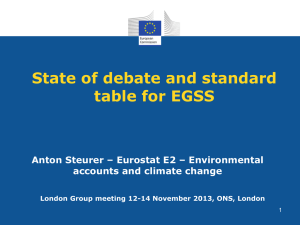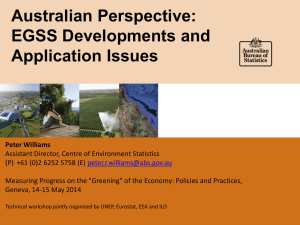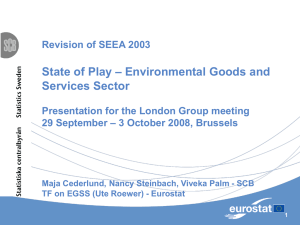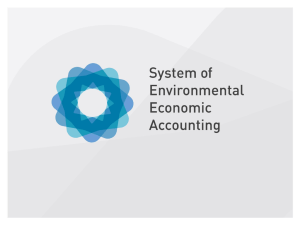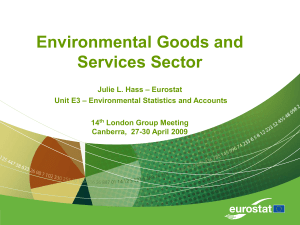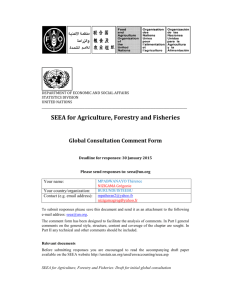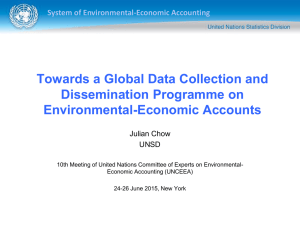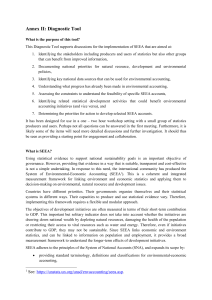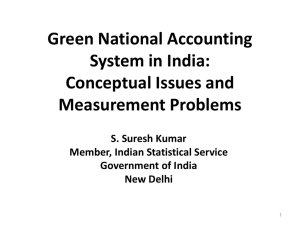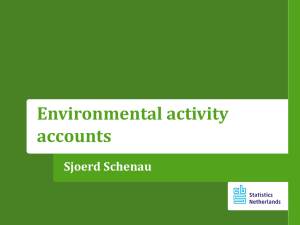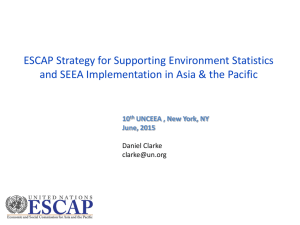2b. SEEA progress report with an emphasis on EGSS (Sokol
advertisement
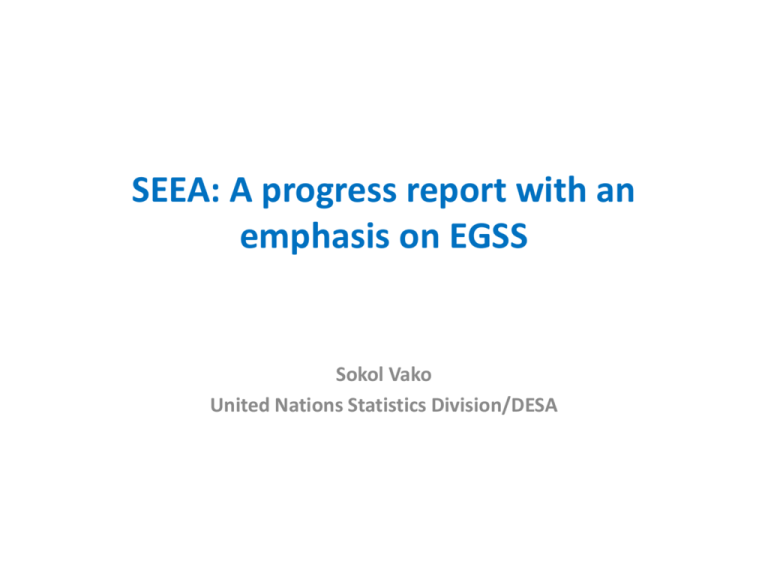
SEEA: A progress report with an emphasis on EGSS Sokol Vako United Nations Statistics Division/DESA Overview • System of Environmental Economic Accounts – Overall policy demands – Broad overview – Global implementation strategy • EGSS – Objectives at international level – Examples in SEEA Applications and Extension – Technical committee System of Environmental Economic Accounts-Overall policy demands • • • • • • • Post 2015 Development Agenda Green Economy Rio+20 outcome document High Level Panel Report Current work of the Open Working Group Broader measures of progress/Beyond GDP World Bank Natural Capital Accounting/ WAVES Purpose of the System of Environmental Economic Accounts • The economy impacts on the environment and the environment impacts on the economy • To understand these linkages we need to integrate environmental and economic information • This is the explicit purpose of the SEEA System of Environmental Economic Accounts (SEEA)-Brief overview • SEEA Central Framework adopted as an international statistical standard in 2012 – Highest level of recognition by the UNSC – Status is the same as that of SNA – Countries encouraged to compile accounts based on SEEA • SEEA Experimental Ecosystem Accounting • SEEA Applications and Extensions • SEEA subsystems – – – – SEEA-Water SEEA-Energy SEEA-Agri (led by FAO) SEEA-EGSS (??) System of Environmental Economic Accounts-Central Framework 1. Flow accounts: supply and use tables for products, natural inputs and residuals (e.g. waste, wastewater) generated by economic activities. • physical (e.g. m2 of water) and/or monetary values (e.g. permits to access water, cost of wastewater treatment, etc.) 2. Stock accounts for environmental assets: natural resources and land • physical (e.g. fish stocks and changes in stocks) and/or monetary values (e.g. value of natural capital, depletion) 3. Activity / purpose accounts that explicitly identify environmental transactions already existing in the SNA. • e.g. Environmental Protection Expenditure (EPE) accounts, Environmental Goods and Services Sector (EGSS), environmental taxes and subsidies 4. Combined physical and monetary accounts that bring together physical and monetary information for derivation indicators, including depletion adjusted aggregates System of Environmental Economic Accounts-Implementation Strategy • Implementation strategy adopted by the UN Statistical Commission – Long-term strategy – Flexible and incremental based on national circumstances – Four phases • • • • Establish national institutional mechanism Self assessment of national policy priorities and data availability Agree on priority and pilot compilation with existing data Preparation of strategy development plan – Creation of partnerships at global, regional/sub-regional and national level System of Environmental Economic Accounts-Implementation Strategy • Technical assistance and training • SEEA implementation guide, compilation manuals, diagnostic tools, technical notes, data quality assessment framework and training materials • Core sets of SEEA tables for data collection and reporting • Creation of partnerships at global, regional and national level, including cooperation with the policy and scientific communities • Advocacy and communication System of Environmental Economic Accounts-Implementation Strategy • Strategic approach to the implementation – National Strategies for the Development of Statistics (NSDS) should be linked to strategic planning frameworks such as the National Development Strategies, National Sustainable Development Strategies (NSDS) and National Biodiversity Strategies and Action Plans (NBSAP) • Linking the implementation to policy demands – The SEEA can serve as the statistical infrastructure in response to existing policy frameworks such as Post 2015 Development Agenda, Natural Capital Accounting and Wealth Accounting and Valuation of Ecosystem Services (WAVES), green economy/green growth, sustainable production and consumption (SPC), etc EGSS-Objectives at the international level • EGSS part of the overall implementation strategy • Country demand driven process • Potential for inclusion of EGSS statistics to measure progress towards the SDGs – Employment statistics – SPC • OWG working document – Focus area 9. Industrialization and promoting equality among nations f) increase by a factor of x the share of environmentally sustainable products and services in GDP g) by 2020 implement plans and measures to strengthen the technological capabilities of industrial sectors, including plans to accelerate development and adoption of environmentally sound industrial technologies and processes h) by 2030 retrofit x% of existing industries on global level based on energy and resource-efficient technologies and environmentally sound industrial processes EGSS-Applications and Extensions • Example of EGSS as part of the part 3 • Key indicators and aggregates – The value added generated by the EGSS expressed as a percentage of GDP – Employment in the EGSS expressed as a percentage of total employment – Exports of environmental goods and services as a percentage of the production of environmental goods and services – Trade (exports, imports) in environmental goods and services as a percentage of total trade – The proportion of enterprises that produce environmental goods and services in the economy – The level of investment in the EGSS and its development over time EGSS-Applications and Extensions • Different kinds of analysis possible – – – – – – Analysis by economic sector and industry Analysis by environmental activity domain Analysis by type of environmental output Regional analysis Analysis of associated physical data Multiplier analyses Technical committee • Technical committee created as mandated by the UNSC • Priority to complete core table and technical note on EGSS • Work programme includes work on classification of environmental activities • Developing repository on training materials and other relevant documents developed by different agencies EGSS-Where do we go from here? • EGSS core tables and accounts (led by Eurostat, role of Expert Group) • Testing of EGSS in developing countries • EGSS training materials – In depth module that could be part of the Training of Trainers suite of products – Training manual • Role of the Technical Committee and Expert Group • Knowledge base on EGSS
